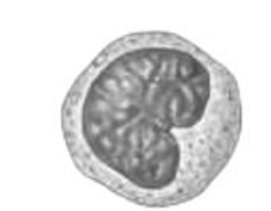
Concept explainers
Introduction: White blood cells (WBCs) are immune cells that play a major role in the body’s defense mechanism. WBCs, also known as leukocytes, protect the body from foreign antigens and infectious diseases. The five types of white blood cells are neutrophils, basophils, eosinophils, lymphocytes, and monocytes.
Answer to Problem 1CRQ
Pictorial representation: The given figure is labeled as a monocyte.

Fig.1: Monocyte
Explanation of Solution
In the immune system, monocytes are one of the crucial white blood cells. Monocytes are amoeboid in structure and possess non-granulated cytoplasm; hence, they are termed as agranulocytes. They differentiate into macrophages. If an infection or tissue damage happens, the monocytes leave the blood and reach the affected area (tissue) and undergo a sequence of changes to become macrophages. They are also involved in the tissue repair mechanism.
Want to see more full solutions like this?
Chapter 17 Solutions
VISUAL ANAT.+PHYS.-PKG.
